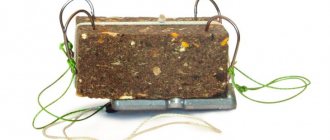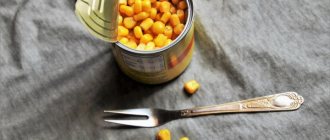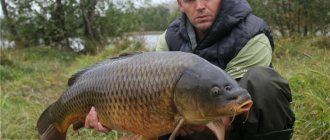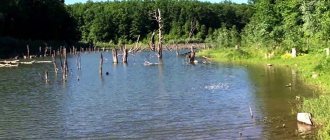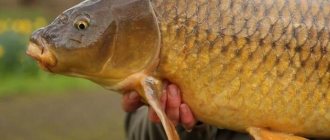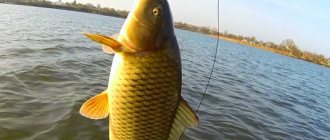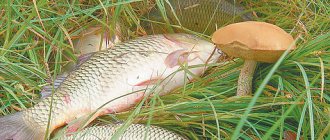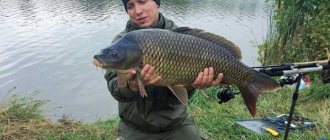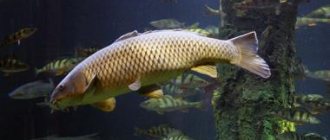Yuri 09/11/2020 903
Catching carp with cake in Astrakhan is famous for its efficiency and method of equipment. It is sold in specialized fishing stores in pressed briquettes. Next, you need to divide it into small pieces and make a hole for the tackle. Next, we’ll look at how to catch carp using cake, prepare equipment, choose a place and fishing tactics.
The essence and types of cake
Privads of this type are a by-product of the process of obtaining vegetable oil, the pressed mass of which is pressed into dense blocks and supplied to retail fishing outlets in the form of layers for further cutting into the required sizes or already packaged briquettes. The compressed substance has a persistent aromatic odor from oil residues and when placed in water for a long time, it begins to decompose into small particles and release fine turbidity.
Read more about what fishing cake is and how you can prepare it yourself.
Cake fishing is based on supplying the above-described bait to the fishing point, including several hooks on short leashes. When a fish approaches the smell, it begins to suck on the tasty briquette and in this process absorbs the hooks, thereby becoming a fishing trophy. Briquettes made from sunflower seeds have become widespread. They occupy the bulk of the product among the tops. But there are also varieties made from flaxseed and soybean seeds, which are more expensive than the sunflower product, but are also effective in practical use.
Video about cake fishing
A sized piece of aromatic delicacy is placed on the pulp cake. 4 hooks, size 6, 7 or 8, are inserted into the corners of the piece. The size of the complementary food can vary; in a stagnant reservoir you can make it smaller, in reservoirs with a current - larger. The main task is that the bait should remain in place and attract fish.
After the rod is cast, it is placed on a rod or a special stand, a bell is attached so as not to miss when the fish bite, and wait for the bite. As you can see, there is nothing supernatural in catching fish with cake, except for the great pleasure of a good catch.
Basic requirements for cake
Pressed bait briquettes are a specific product, when choosing which to fish for, the fisherman must pay attention to its quality, otherwise the fishing efficiency can be significantly reduced, and the fish expected at the point may not be suitable at all.
The main requirements for cake are put forward in terms of its freshness. The fresher the briquette, the stronger the smell. Sunflower bait smells pleasantly of halva. When choosing a packaged product, pay attention to the absence of mold and distinct color. The color of the suitable bait is in bright black and white tones, without dullness or blurriness. An important criterion is the density of the substance.
Important! Tactilely, it is a non-crumbly and elastic product without fragility and pronounced plasticity.
Store the baits in the refrigerator on the lower shelves in plastic bags to prevent moisture penetration. If you need to obtain certain pieces, it is most convenient to use a hacksaw, which cuts the product without creasing the edges in the desired geometry. Also, using the same hacksaw, carefully, without crumbling the edges of the product, cuts are made to secure the attachment in the loaded holder of the mounting equipment.
Benefits of using bait
Fishing for carp on the makushatnik has a number of clear advantages over other types of hunting. First of all, this product in installation represents both bait and bait. An important factor is that, due to the design features of the equipment, it is possible to attach the cake when fishing for carp in each installation quite reliably, which facilitates unhindered long-distance casts.
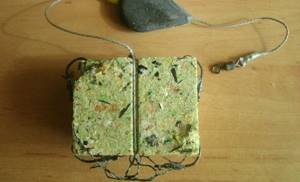
Important! The nozzle works for a long time and does not require frequent replacement. If there are no bites, the cakes are changed every three hours.
Even the daily consumption of briquettes per rod will not exceed a couple of hundred grams. Simple storage and technically simple processes of dividing the bait layer into the required pieces also add comfort to the fishing process. The availability and low cost of the product, as well as the possibility of preparing it yourself, add advantages and continue to popularize the bait for ever wider use in fishing.
Macha and cake in bait and bait
The cake granules go into the bait entirely, like pellets for fishing. Whatever form the makha is in, it can always be crushed, ground and used as an additive to bait or an ingredient in bait.
Groundbait with makukha
One of the bait recipes for fishing using makukha, sent by our reader:
Makuha is a good way to feed fish. It has the smell of seeds and is considered a popular ingredient that experienced fishermen often add to bait. Any bait must be approached competently, since it plays an important role when fishing both with a float rod and with a donkey with a feeder.
One of the types of bait for carp, crucian carp, bream is quite easy to prepare and does not require any special knowledge and is prepared simply at home, and the fish really like the taste and smell (tested by experience). It is very good to add macadamia to the bait; it gives an incredible aroma that many types of fish really like.
Preparation:
- Take 2 cups of boiled millet, rinse it so that it does not stick together;
- Add semolina there for viscosity and mix with 150-200 g. makuhi.
This bait is very simple to prepare, but it is effective for luring fish; the miraculous smell that the top creates has a stunning effect on the fish, which actively approaches the feeding site.
Application:
Balls of bait fall to the bottom and gradually dissolve, so it is important not to overdo it with substances that make it sticky, because many fishermen know that in stagnant water the bait does not act the same as in a river with a current, and if the bait is not applied correctly, the fish can be scared away, not attracted, and fishing may be unsuccessful.
You can also use store-bought baits, baits, baits packaged in bags by weight; they also attract fish to the fishing site with their smell, this is the first thing. The second thing is that it is very convenient to use almost ready-made groundbait by adding some components, for example, makukha.
Boiled groundbait
This bait is prepared immediately before fishing. It is an ordinary porridge, so it does not last long and it is advisable to use it at a time. This bait for carp has a more attractive aroma, retains its shape better and is perfectly retained in feeders. In addition, as a result of cooking, it increases in volume as the plant components swell.
If desired, you can prepare it crumbly if the fishing conditions require it. In order to make such bait, you do not need to look for flour. To prepare you will need:
- egg grits;
- Wheat groats;
- corn grits;
- split peas.
You can use one ingredient or mix several of them and add three parts of water and cook like regular porridge. If it turns out not viscous enough, you should add a little flour to it to absorb excess moisture. If this is not done, then at the pond you can add a little clay to the porridge. This will reduce its consumption and allow you to sculpt durable balls for casting.
It should be remembered that after cooking the volume of bait will increase!
To add flavor, it would also be a good idea to add strong-smelling ingredients. In order for them to mix well, this is easiest to do at the cooking stage after removing from the heat, until the porridge has cooled. If crumbly bait is required, then in this regard it would be an ideal solution to cook pearl barley. In addition, it can be used as hook bait.
Nozzle with pulp
If there is no cake, no problem. To prepare the bait, regular sunflower seeds are suitable.
Tackle for catching carp with cake

Tackle lengths of 3.5 meters ensure casting range, and tests over 100 grams ensure reliability when feeding heavy rigs. The reel must be equipped with a baitrunner and have a capacious spool to collect at least 100 meters of fishing line with a diameter of 0.3 mm. The manufacture of makushka equipment involves the use of bases made of monofilaments of 0.3 -0.5 mm. The monofilament ensures safe fishing for even a significant trophy weighing a couple of tens of kilograms. Blind or sliding lead flat carp sinkers are used as fastening platforms for baits, with mounting holes for leads and slots for securing the briquette. Leashes are used from braided lines of 0.12-0.15 mm, 5–7 cm long. From one to seven units of this element can be used on the tackle.
Hooks for leashes are knitted in sizes 4–6, in types with a short shank and in a discreet dark color. One of the features of the makushatnik tackle is the use of a shock leader in its equipment, which ensures comfortable fishing on currents and on the bottom with shell rock. And the coastal fight against powerful fish becomes more confident on fishing lines that are thicker in relation to the main line. The finally assembled tackle looks like a briquette of bait rigidly fixed on the platform, where hook leads are inserted into its body at the corners.
Important! The nozzle layer is secured with rubber bands. Hooks are placed in the corners based on the fact that the fish begins to savor the bait from these sharp edges.
Making a makushatnik with your own hands
Let's look at how to make a makushatnik with deaf fixation; for this you need to prepare:
- metal plate;
- cake;
- ring;
- hooks for carp;
- braided thread;
- rubber bands.
To create a carp pulp with your own hands, first make leashes 8-12 cm in size from woven thread with hooks. If the crown measures 4x5 cm, then make 4 leashes. Then a metal plate is cut out according to the size of the crown. A hole is drilled at one end of the plate, a ring is installed in it, to which the main fishing line and leashes with hooks are attached.
Then you need to put the leashes on the sides of the plate and secure the end of the cake with an elastic band. The two shortest leashes are pulled out from the side; they will be installed in front. Then the back end of the cake is secured with an elastic band. Holes for hooks are made in the corners of a piece of cake. Instead of an elastic band, you can screw in self-tapping screws.
The manufacture of a sliding-type crown will require the use of the following materials:
- cake;
- a sinker that can slide;
- braided thread;
- carp hooks;
- silicone stoppers;
- wire;
- swivel with carbine.
First, a sinker is placed on the main line. Below, 2 stoppers are installed to protect the knot. At the end of the thread, a swivel with a carabiner is installed, to which a loop of thread is fixed, the size of which should be. sufficient for a piece of topstock to pass through, in which a longitudinal hole is drilled, and leashes and the main line are passed through it.
The leashes are attached to a carabiner, a cotter pin is made from wire, the tendrils of which are threaded into the hole in the pulp. The wire should be of such a diameter that the cake holds it firmly. The main line is attached to the head of the cotter pin. Then they insert the hooks into the cake on both sides, because When casting a rod, the top of the rod can fall to the bottom in different ways. You can attach the cake by clamping it with a loop on the main fishing line.
Sinker
The sinker can be of any shape, but the most popular type is the “dovetail”, because it can be thrown further than other types. The weight of the weight is chosen for a pond - 60-80 g, for a river with a current - 80-180 g.
fishing line
To catch carp, a fishing line with a diameter of 0.45 mm and a length of 100 m is used. It is best to use a monofilament thread; this will be enough to create a top, which is cast manually or using a fishing rod equipped with a reel.
Leashes and hooks
Leashes are used 5-7 cm long, made of braided fishing line or monofilament thread with a diameter of 0.35 mm. The leads are fixed to a special latch, on the back of the plate or in holes. Hooks must be strong. It is better to use hooks for carp No. 4-6. The hook size is chosen depending on the weight of the intended prey.
Selection of promising places for fishing with a mace
Catching carp with cake begins with selecting a promising place. As a rule, flocks of carp live in large rivers with slow and medium currents, preferring to stay at depths of three meters and above on solid bottom foundations with the presence of shell rock.
Important! When selecting a fishing spot, they focus on differences in depth and edge boundaries, where the main channel of the river turns into quieter backwaters.
The presence of isolated snags and artificial, often discarded building or shipping structures, are also included in the area of interest for both fish and carnivores. Water areas in the area of water dams, bridges and embankments with smooth descents of shallows into depth also meet the criteria for a fishing spot. The bottom topography is studied in advance using marker rods or echo sounders.
Fishing technique and tactics
Having chosen a fishing area on a reservoir, you must first feed it. Since the makha gets wet after 30-40 minutes, you need to throw odorous mixtures into the water in advance. If sunflower cake is used, then the area is fed with crushed seeds. When choosing how to catch carp using cake more effectively, you can try smearing the cake with halva, so the fish will detect the bait faster. They make mugs, set-ups, and girders from the top, then throw the gear into the river, put the fishing rod on a stand and set the tension of the main line.
Then turn on the baitrunner if the reel is equipped with one. The arrow points to the baitrunner lever. When the fish finds the top and touches it, the tip of the rod will tremble. The fisherman should pay attention to this, but should only hook after the fish has taken the bait and is hooked. With this fishing scheme, fishing is carried out confidently; the main line should not weaken.
The clutch can be used to loosen the spool to allow the carp to shed a little thread. When you feel the fish give in, slowly apply the brake. At the last stage, a landing net is used, because a fish, sensing a strand near the shore, can make a powerful jerk.
Seasonality of fishing

Fishing time is considered successful when the water is warmed up above 12 degrees. At this time, carp begin active feeding, intensively moving around the reservoir.
Important! As a rule, gear for catching carp using cake is most effective from July to September.
During this season, the fish switches to eating plant foods and is more willing to follow the smell of fresh corn. On sunny days, bites most often occur in the early morning hours and at the transition of the evening to distinct twilight. In cloudy weather, fish can bite throughout the daylight hours. Intense heat transfers flocks of carp to a purely nocturnal lifestyle and, accordingly, feeding. Heavy rains and sudden cold snaps with northern and eastern winds make the bite passive. Any warming with a change in wind to the south will activate the bites.
What is a makushatnik?
In the fishing community, a makushatnik is a tackle for catching carp using cake, the remains of butter production. Most often, pressed sunflower pomace is used in this capacity; corn flour is less often used. Other types are used less frequently in fishing due to their high cost.
Pressed cake can be purchased both ready-made in fishing stores and at collective farm markets in the form of shapeless pieces. In the first case, the flour may additionally contain additives and flavorings, such as:
- honey;
- vanilla;
- hemp;
- cinnamon;
- anise;
- other additives.
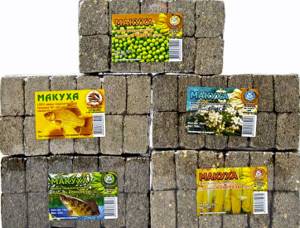
A variety of store-bought bait for carp fishing
When purchasing large-piece cake, the angler has the opportunity to cut the bait of any size and shape.
Advice! It is best to cut out a suitable block from a piece of cake using a hacksaw. This way the top crumbs less, and the workpieces are more even.
The second most important element of a fishing rod for carp fishing is the sinker. It can have different shapes depending on the installation method. Its main task is to hold the cake at the fishing point and ensure that the fish catches itself when biting.
The equipment for catching fish also includes 2-4 leashes with carp hooks for hooking fish. Under water, they interfere with the carp approaching the treat, and he, trying to get rid of the annoying interference, tries to pass them through his mouth.
As a result, the hook gets stuck in the fish's mouth, and the carp is hooked. This is facilitated by a tight leash tied to a heavy load.
Organization of a promising location
Having determined the water areas suitable for fishing, it is imperative to pay attention to the coastal point of placement of equipment for catching carp with cake. Firstly, the exit to the shore should be clean, flat and shallow, which will greatly facilitate the recovery of the caught fish. Secondly, there should be no obstacles on the shore that interfere with casting, and casting will have to be done over long distances with a strong swing from behind. To secure the tackle, you will need to arrange a device in the form of a pole driven into the ground. It would also be useful to organize a place to store the caught trophy with the opportunity to release the fish into the reservoir and securely secure the kukan. Fishing in this way will require more than one spent hour, and a well-planned and prepared camp will allow the fisherman not only to fish, but also to relax during a relatively calm period without biting.
How to catch carp using cake
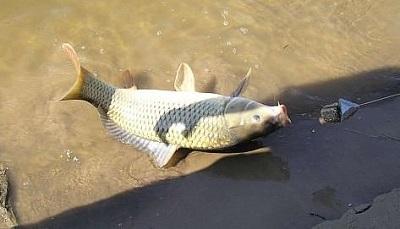
Having selected a fishing point and organized the location for installing the gear, load the bait and deliver it to the fishing zone, equipping the rod with a bite alarm. In moderate and medium currents, use a hard-density bait. In stagnant waters, soft and more easily soluble maca briquettes are used. The friction brake setting on the reel is checked and the baitrunner function is turned on.
Having found the bait, the carp sucks in the hooks and moves away from the installation to the side, which the fisherman determines by the prolonged and non-stop operation of the alarm. In all cases, the fish hooks itself and does not require a strong control hook from the angler. After giving the signal, the rod is raised upward with the quiver tip and the cord begins to wind, pulling the trophy to the shore with the form.
Carp is a powerful opponent that offers decent resistance and fishing requires constant monitoring of line tension. At the moment of struggle, when the tension is loosened, the fish can twist the cord around the body and cut it with notches on the radial bone of the front fin. The trophy brought to the shallows is brought into a landing net, because it is unlikely that it will be possible to take it in the water with the hands of an elastic and evasive strongman.
Techniques for catching Akhtuba carp with cake: casting, biting the carp, fishing and catching
— Equipment of the fishing spot and casting of gear
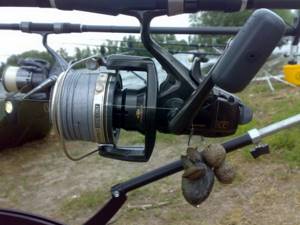
First of all, maximum silence and camouflage should be observed, since the carp is very careful and at the same time clearly sees and hears all extraneous sounds. Therefore, lay out all the gear and accessories on the shore or in the boat so as not to make unnecessary noise and so that everything is at hand, put everything unnecessary aside, install the fish tank in the water in advance or prepare a kukan. The gear is thrown from the stern of the boat downstream, and from the shore parallel downstream diagonally. Having chosen the fishing line, the rods should be installed so that their ends form one line - it will be easier to notice the bite. It is advisable to use special holders, flyer bipods on the shore or attachments to the side of the boat. Never leave a “loaded” tackle for carp unattended without tying the rod to a reliable anchor on the shore or securing it in a strong stand - there are often cases when a large carp or a catfish flattered by pearl barley simply dragged the rod into the water with its ends.
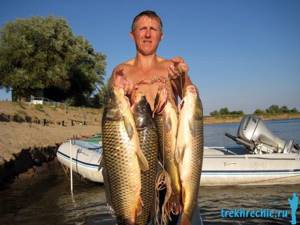
After a short period of time, 2-5 minutes, you will probably notice slight twitching of the fishing line, trembling of the ends of the rods - this is the smell of the bait that brought up small fish, but we don’t need it. Therefore, maintaining Indian calm, we continue to watch the gear in anticipation of the “big fish”. The only downside is that after 15-20 minutes, with active attacks from small fish, the cake will be torn apart and sucked, so you will need to pull out the tackle, replace the nozzle and cast again. If everything is done correctly, and the carp does not bite during the first 30-40 minutes, then a mistake was probably made in choosing the place and the carp is not here now - we change the fishing location. Or perhaps he is not satisfied with our nozzle at the moment - we change the nozzle. But if you are confident in choosing a place, but the carp does not bite, then most likely it is not caught anywhere at the moment - there is a change in the weather (wind direction, changes in atmospheric pressure) or water level, which happens quite often in the Lower Volga, since the level here depends on the operation of the spillways of the Volgograd hydroelectric station. In this case, you will have to stop fishing or try to switch to catching another fish: a predator with a spinning rod or bream, crucian carp, buffalo with bottom tackle or a side fishing rod.
— Bite of carp on a meal trap
You won't miss it, believe me. A large carp bites unexpectedly and powerfully. Usually

First, the line begins to stretch, the slack is taken out, after which the first pull follows. There is no need to rush into hooking at this moment; it is better to give the carp time to swallow the bait deeply to be sure that the hook is already in its mouth. But you need to get ready, grab the butt of the rod with your hands without removing it from the stand, and put your fingers on the handle of the reel. During the second pull, you should make an energetic sweeping sweep. The fact that the carp is firmly hooked will be indicated by serious heaviness at the end of the rod, powerful jerks and the activation of the friction brake of the reel, which should be adjusted to approximately 50% of the tensile strength of the fishing line.
— Fishing for large carp
Now you have to take the caught carp to the shore or to the side of the boat. Having been caught, a carp, depending on the surrounding conditions, can take the following actions: - rush with all its strength into the depths towards the riverbed, respectively, in the direction from the fisherman, while making jerks and sharply changing direction. This is a good option for the fisherman, unless there are heavily snagged riverbed holes nearby, where carp can entangle the tackle in branches and roots; - sharply rush to the shore and to the side in search of a flooded tree, reed or snag in the pool under the steep yar. This is worse, because the line instantly sags and the angler loses control over the fish. A caught large carp always resists desperately and very stubbornly. It's important here
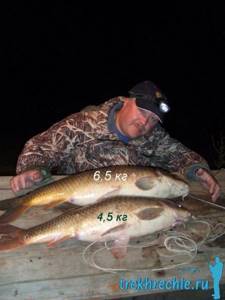
try to dampen its throws and jerks by using the rod and reel clutch. Don’t try “with all your might” to counteract a large fish, don’t force the landing - with the next jerk the carp will simply break the tackle or break the spinning rod. This happens quite often among inexperienced, impatient anglers.
A preliminary careful study of the water area in the carp fishing area is the key to a successful fight against large fish. The task is to provide the caught carp with some freedom, but constantly making efforts and restraining it, to exhaust the enemy as much as possible, to force him to obey the actions of the fisherman. Therefore, do not be greedy and let the fish pull the line from the clutch, smoothly restrain the next strong pulls with the work of the rod. After some time, the enemy will begin to get tired, jerks will become less frequent and with less amplitude. We begin to actively select the fishing line as soon as the tension allows it. When fishing for particularly large specimens, in order not to overload the reel, it is better to “pump out” the fish with the rod, quickly reeling in the line in the intervals when the rod goes down.
When pulling the carp to the boat, it is better to remove all gear that could entangle the caught fish, and the motor should be raised out of the water while fishing.
— Taking carp into a landing net
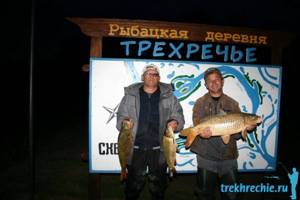
The landing net should always be at hand and lie in such a way that at the most crucial moment you do not have to untangle it from the roots and bushes. You should not force events, show restraint - sudden movements and fuss can frighten a large carp and it will make another desperate attempt to free itself. A sign that the fish is tired and giving up is the appearance of bubbles on the surface. We start working with the landing net when the tired fish is near the boat at the surface - we lower the hoop into the water, pull the prey along the surface above it, and at the moment when the carp falls on its side, we sharply move the landing net up and forward, at the same time slightly loosening the fishing line. That's it, the trophy is in our hands!
You can store caught carp in a long, spacious cage or on a fishing line made of thick fishing line if you are fishing from the shore. In a boat, you can use a plastic container with a ventilated lid and a wet rag inside.

